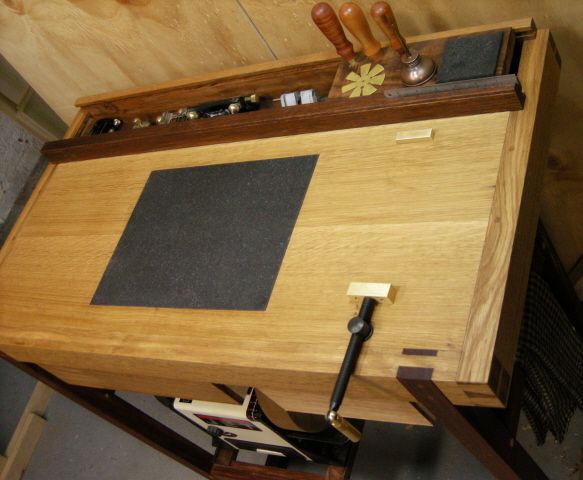
Read parts one, two, three, four, five, six, and seven for more details on this project.
Drawers and Details
In my last post I finished gluing the bench together so now I’m ready for the drawers and the details. I should apologise for taking so long to post this last article but was waiting for one final element to arrive through the mail to complete the project. The drawers and the details were actually finished on Sunday past and I’ve been using the bench for the last few days. I’ll give some feedback at the end of the post.

The first detail element was the sliding tool holding tray. This is simply a piece of walnut scrap wood cut to size and rabbeted on both edges. It will slide along in the dados I cut out on the back splash and rear cross apron of the tool tray.
Again with cutting rabbets I began with my skew rabbet plane to begin the cut, and once established I move over to my medium shoulder plane. A few final passes with a smoother across the surface and I’m ready to mark out the tool holding features.
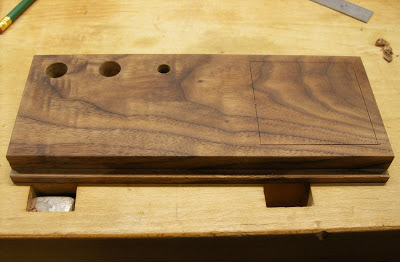
While sharpening there are a handful of tools I always have withing arms reach and this is the place to store them. For my ‘essential trio of screwdrivers’ I bored out some holes to fit the screwdrivers and at the opposite side of the stock I carefully laid out and scribed for an ‘oil well’. When I finish my sharpening routine, the last step I take is to apply a coat of Jojoba oil to the tool iron and this oil well will make this a simple process. The oil well is a common bench accessory often seen in old wood working books and it was an element I’ve always wanted to incorporate into a bench design.
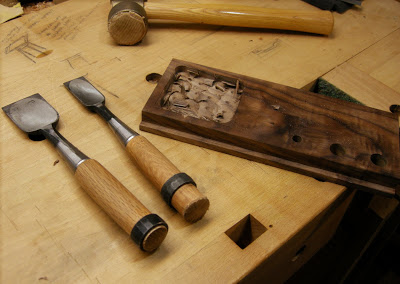
I remove the bulk of the waste with a forstner bit and some chisel work to complete the excavation. I then cut up some foam I had and it’ll get saturated with the oil. A simple luxury for the sharpening bench complete.
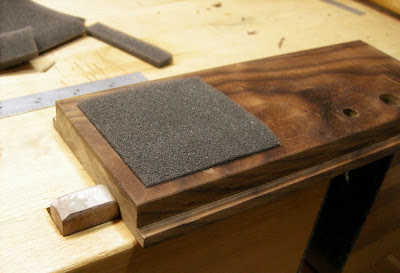
The next detail I addressed is a small stop or fence that my water stones will butt up to while in use to prevent any movement. I had a small piece of brass stock sitting in the bottom of my tool cabinet for the past five years and finally found a use for it. To begin I clamped a file into my shoulder vise and cleaned up the surfaces of the brass stock.
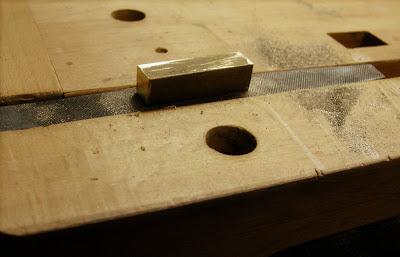
Then I measured and scribed the location in my bench top.
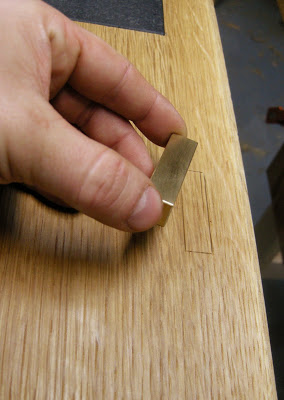
To remove the small area I began with a series of chisel cuts and follow with my small router plane to complete. The router plane makes it easy to obtain a uniform depth in the cut out.
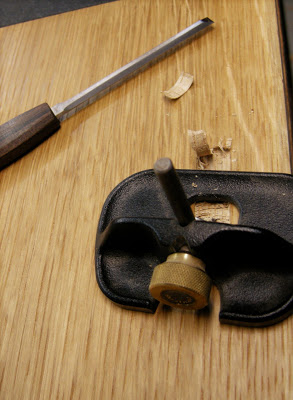
At the front edge of the work surface, in line with the newly installed brass fence I drill a 3/4″ hole to install a Veritas ‘Wonder Pup’ clamp. These are extremely versatile work bench accessories and it’ll become a kind of miniature vise for my stones. I occasionally use some different size stones and wanted a system that would be able to adapt to the stone sizes. With the hole drilled I insert the clamp. (note: in the downloadable bench plan available this hole is shown in the front apron; I decided to move it onto this top surface location feeling that a 3/4″ hole down into the apron would weaken it)
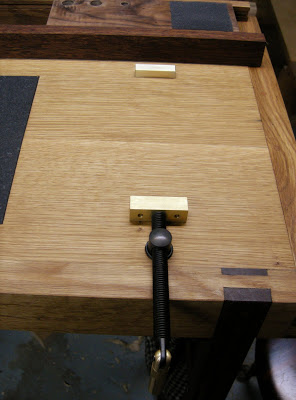
While I had the back splash removed for cutting out the mortise for the brass fence I decided to saw a kerf into the top, outside for a place to store my small ruler. I use the ruler while honing a tiny back-bevel into my plane irons and this is a handy location to keep it. I scribe a deep, crisp line into the hardwood and follow with my Dozuki saw which cuts on the pull stroke. This allowed me to make this saw kerf without any damage to the rest of the piece.
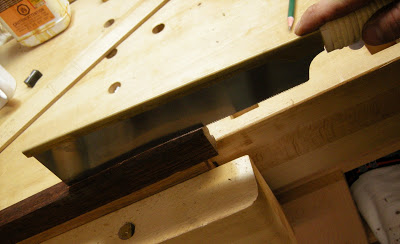
The sliding tool holder, the brass fence and ‘Wonder pup’ installed and a saw kerf to place my ruler I call the top details done and consider the shelf on the bottom of the bench. After looking around my shop for a suitable off cut and coming up with nothing, I decide to make a pair of fitted stretchers that will come to hold my slow speed wet grinder.
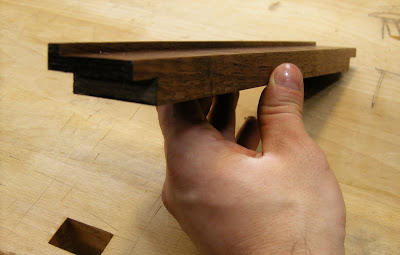
I didn’t really have a list of items I wanted or needed under there so instead of the full shelf, for the time being these two stretchers will do the job.
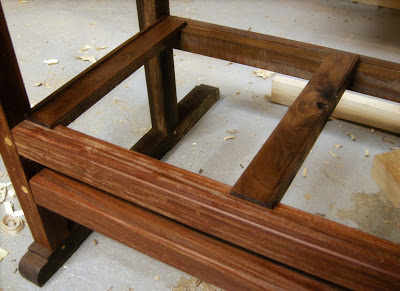
I cut some shallow rabbets into the sides of these pieces to act as stoppers for the feet on the grinder. The small shoulders cut at each end create a nice tight fit and the two stretchers are pressure fit only.
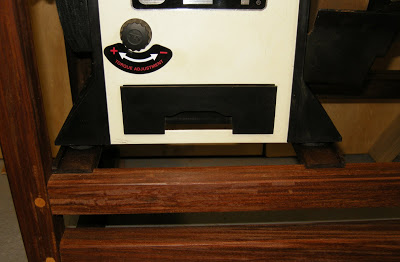
The Drawers
I thought about making a couple of dovetailed drawers for this project but after reading an article written by fellow Canadian craftsman, Hendrik Varju in issue #208 of Fine Woodworking Magazine on a pinned rabbet drawer, I decide to simplify the process and cut down some time in the shop. Christmas is a little over a week away and I really wanted to get onto some other gift projects. With that in mind I selected and prepped the stock for the drawers. Oak for the fronts and poplar for the sides and back with Marine Grade plywood for the bottoms. (you’ll see why in a minute)
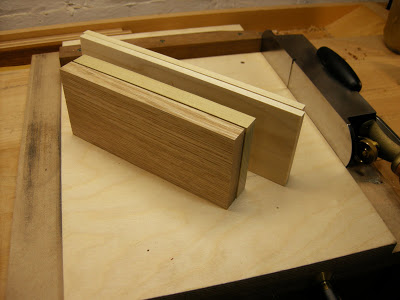
The drawer construction is fairly quick using my backsaw to rough out the rabbets.
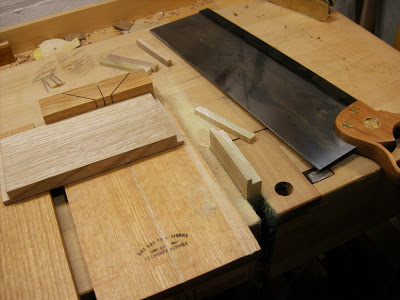
I clean them up with a shoulder plane and scribe the drawer sides for the drawer bottoms as well as the outside groove that will hold the drawer runners. Using this rabbet construction also makes the drawer bottom grooves faster not having to worry about cutting stopped dados in the front and back pieces. With my small plough plane I cut the dados.
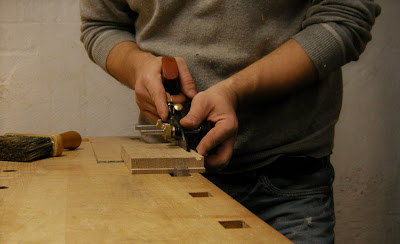
The drawer rails are of oak and my rip saw cuts through in a hurry.
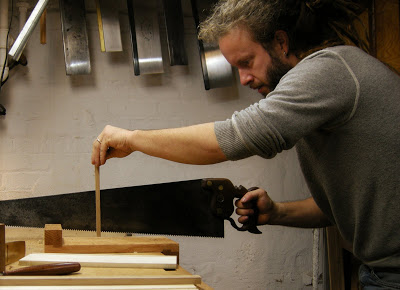
In the next shot you can see the drawer pieces dry fit and the joinery for the components.
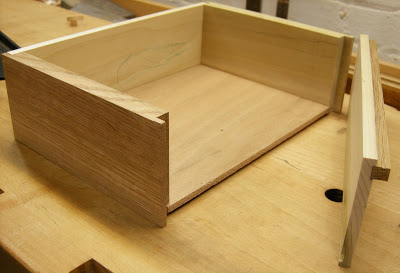
A generous amount of water resistant glue and I clamp up the assembly and let them sit overnight.
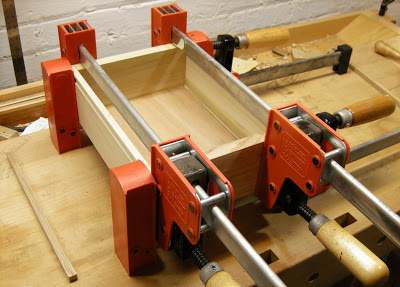
In the morning I scrap off any squeeze out and plane the outside of the drawers for a final fit. I also decided to take 5 minutes and scratch some quick beads into the top and bottoms of the drawer fronts. This is a workbench but a small detail like this elevates the design and will show future generations the pride that went into making this piece. Besides, I don’t think I’ve made a piece over this past year that hasn’t had a bead scratched into it somewhere- maybe a sort of signature? Find some small details you enjoy and try incorporating them into your own work. It personalizes the piece and tells people that its yours.
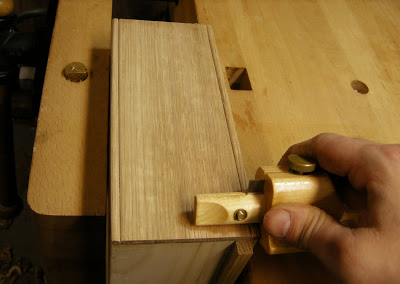
So the next step is one that may be a little foreign to some but having a back ground in boat building made this a familiar procedure in the process. The smaller right hand drawer gets completely sealed with fiberglass on the interior. Working with epoxy resins and fiberglass tape involves some safety matters and anyone doing this work should carefully read and understand the process involved. A respirator, rubber gloves and well ventilated area are wise. I assembled all of my tools for the process and mixed up a small batch of resin. Once mixed you don’t have a lot of time to work and I completely missed the opportunity to take photos of this step. My apologies.
The steps I took were as follows: Mix the first batch of resin and paint the entire inside surface of the drawer making sure to get good, thick coverage in the corners. I pre-cut to length some pieces of fiberglass tape and laid them out on some wax paper. A second batch of resin was mixed and the tape was saturated with the resin. Then all of the inside seams are carefully covered with the saturated tape and again a thick coat over top. Let it cook for awhile in a well ventilated area but making sure it stay warm to cure. The drawer is installed into the guides and filled about 3/4 of the way with water. This is now the location my four water stones will reside.
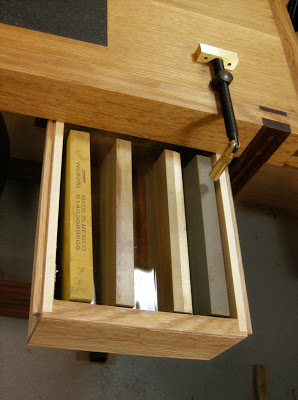
The second larger drawer on the left is also installed and becomes a place for additional storage. Items like my slip stones, flattening plate and files stay within reach of the work space.
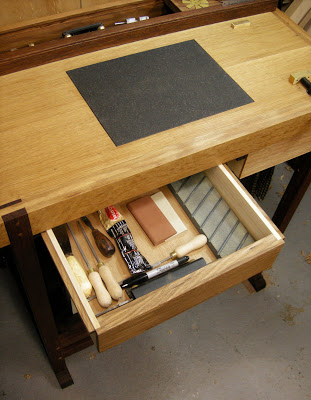
With the two drawers finished and the top details complete I sit and wait patiently for the mailman to arrive…fast forward to this afternoon and my package shows up. My new Gramercy Tools 14″ saw vise is the final element to complete the bench. I’m sure most readers would have thought of this bench for sharpening only plane irons and chisels, but a true sharpening bench in a small workshop needs to serve dual duty and will become a complete sharpening station in my woodshop.
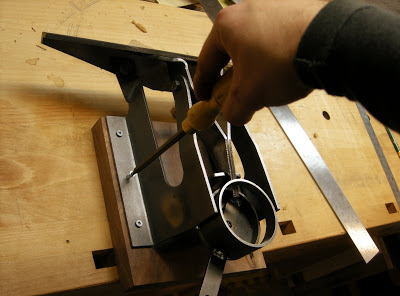
The vise is easily mounted on a thick piece of hardwood and for the sake of today I simply clamped it to the front left side of the bench. One last thing I did was bore out a hole in the back splash for my work light to slide into and I can finally call this project complete!
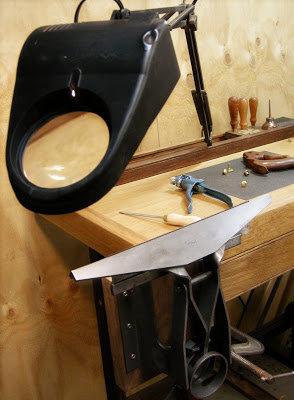
In the next few days I’ll pick-up some anchors and install them into pre-drilled holes in the bench creating permanent locations for machine screws to go. This will make the process of mounting the saw vise and firmly securing it a quick and painless task. (this is also another great reason to flush up a the legs on a workbench with the front apron-making additional work holding and clamping much easier)
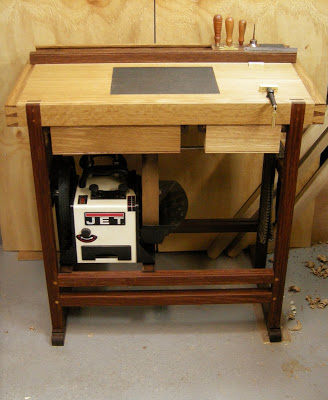
This was a very rewarding project to build and a lot of fun details to come up with through the process. If you’re a power tool user then I’m sure a project like this would only take a few days and in my shop using only hand tools, I happily picked away at it over these last couple of weeks. Probably no more than 40 hours total went into the build and the budget was kept pretty tight.
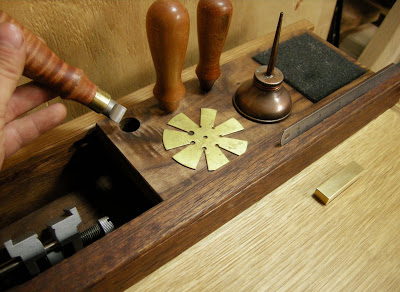
I’m happy with the results and can say that my sharpening routine has indeed become much more pleasurable and efficient having this dedicated sharpening bench. Thanks for reading- cheers!
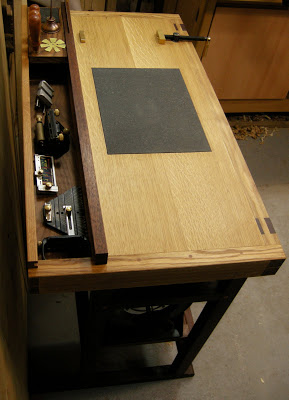


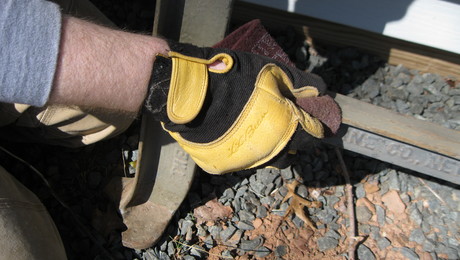
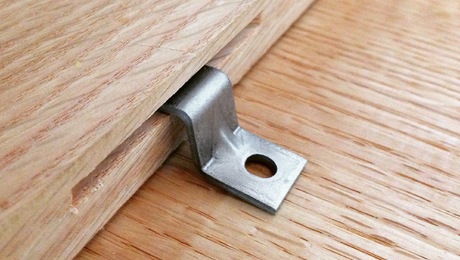
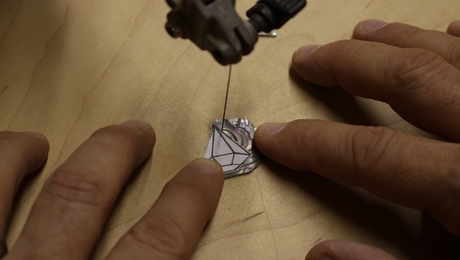

















Comments
Very nice work. All the hand work makes me very briefly consider tossing my power tools :). What are you going to build next?
Thanks for the comment JeffB-
I've already started my next project which is a small wall cabinet. It's a Christmas gift so I'd better get cracking on it ! I'm also finishing off a design for a very big commission I just got- it's a fold away bed cabinet + table top and side storage closet. A couple here in Toronto live in a small one room condo and want to save some space. A challenge for me to design something that will be not only practical for all of their needs but aesthetically pleasing as well.
all the best-
Tom
I really like this table. I have recently started using more hand tools and can appreciate a sharp tool vs a dull dud! I need to build a sharpening area too. It will not be as nice as this one, but great ideas. I think I will use that leg idea in my future work if thats ok. Looks great! Thanks again.
The table turned out real nice! What a luxury for a hand tool user. I have wanted something like this for a long time. I also enjoy reading your blogs. Well done and thanks.
Tom:
A lovely project! I have been re-finding my way with hand tools recently, and the project is inspiring to me. One question I have is the finish for the top. I noticed in previous installments you used boiled linseed oil and paste wax, but to maintain your water stones you made a fiberglassed drawer. Did you consider a more waterproof finish for the top? I am wondering because my recent experience with a slow wet grinder (Delta) and waterstones results in a lot of water on the bench top I use. I have been using a cookie sheet (didn't steal it from my beloved--I learn from my mistakes) to try to keep things dry, but it is an imperfect solution. How do you deal with water on the top from sharpening, and do you think the linseed oil/wax will hold up?
thanks for all of the comments-
TedFurlong- I went with the oil and wax finish for the easy maintenace of it. this is still a workbench and although it's nice to look at new, I'm not too concerned with any water damage. the white oak is a great species for any high moisture areas and the oil and wax finish will be easy to maintain and touch up. when the oak starts to patina and perhaps even ebonise and turn black from moisture- I think I'll enjoy it. I like watching wood age through daily use and hard work!
cheers.
It's amazing to see that you get it done with just hand tools. It's just too much...
Thanks for posting, I enjoyed the whole series.
Is it because I am not a boat builder, that I fear water problems around the granite insert and the wood on top of the water stones drawer?
Nice job & very practical!
Really nice work, inovative thinking and a beautiful result. Including the saw sharpening tools was a nice touch. Thank you for sharing it.
Forgive me if I am leary of the water drawer. I am concerned about two issues:
1) (the obvious) Will there really be no cracks/leaks with a fibre glass layup on top of a plywood bottom and sides of solid wood?
2) With all that water in the drawer, are you concerned at all with collateral damage to the surrounding wood? (I am thinking uneven moisture content, mold formation etc.)
Perhaps you could do a follow up to this blog in 6 months or so and let us see it after it's broke in?
I really enjoyed this series of blog entries and watching your process. Was thorough and engaging. A couple of things I'd like to see--a quick materials list with approximate cost of the items. I know you used some pieces you had around, but a general idea of what they might cost would be helpful. Also, what kind of granite did you use, where you got it from, and what the dimensions are for it. Mostly just interested in the details of the project. Also, it would be nice to see a short video of you showing the bench and discussing the various elements of it. Still photos are great, but sometimes a short video can be illuminating. Thanks, ken
Very nice bench. I am considering making something simlar for sharpening, probably out of some scrap LVL a builder friend gave me. I did wonder, how did you attache the stop to the tabletop? More Epoxy? The mortise did not seem to be deep enough for it to hold by itself. I would also wonder why not just use a bench dog or pup to act as your stop, as then you could remove it if you ever needed to.
Doc
how long did it take to build it and what kinds of woods are best
Great plan! I was planning on putting my sharpening tools, which includes a big 8" bench grinder for turning tools on a rolling shop cart, but this plan might change my mind!
I particularly like the bench dog system for holding items.
Concerning sharpening with water stones, I've always used a plastic cafeteria tray that has a textured surface on the top to hold my water stones. The texture keeps the stone from moving and the tray rim keeps water in place. I would definitely use the bench dogs to hold this in place.
Log in or create an account to post a comment.
Sign up Log in